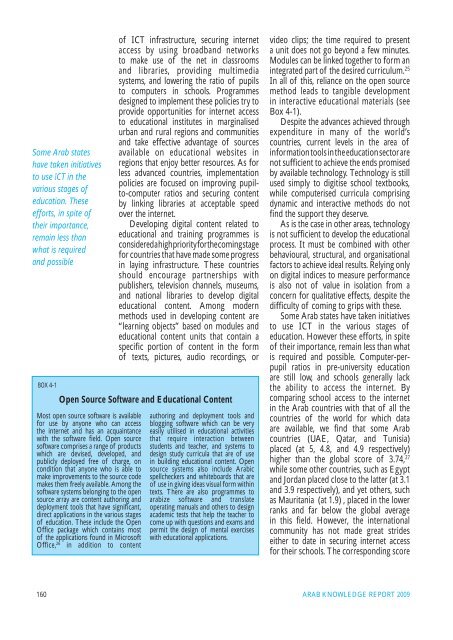Arab Knowledge Report 2009: Towards Productive
Arab Knowledge Report 2009: Towards Productive
Arab Knowledge Report 2009: Towards Productive
- No tags were found...
You also want an ePaper? Increase the reach of your titles
YUMPU automatically turns print PDFs into web optimized ePapers that Google loves.
Some <strong>Arab</strong> stateshave taken initiativesto use ICT in thevarious stages ofeducation. Theseefforts, in spite oftheir importance,remain less thanwhat is requiredand possibleBOX 4-1Most open source software is availablefor use by anyone who can accessthe internet and has an acquaintancewith the software field. Open sourcesoftware comprises a range of productswhich are devised, developed, andpublicly deployed free of charge, oncondition that anyone who is able tomake improvements to the source codemakes them freely available. Among thesoftware systems belonging to the opensource array are content authoring anddeployment tools that have significant,direct applications in the various stagesof education. These include the OpenOffice package which contains mostof the applications found in MicrosoftOffice, 26 in addition to contentof ICT infrastructure, securing internetaccess by using broadband networksto make use of the net in classroomsand libraries, providing multimediasystems, and lowering the ratio of pupilsto computers in schools. Programmesdesigned to implement these policies try toprovide opportunities for internet accessto educational institutes in marginalisedurban and rural regions and communitiesand take effective advantage of sourcesavailable on educational websites inregions that enjoy better resources. As forless advanced countries, implementationpolicies are focused on improving pupilto-computerratios and securing contentby linking libraries at acceptable speedover the internet.Developing digital content related toeducational and training programmes isconsidered a high priority for the coming stagefor countries that have made some progressin laying infrastructure. These countriesshould encourage partnerships withpublishers, television channels, museums,and national libraries to develop digitaleducational content. Among modernmethods used in developing content are“learning objects” based on modules andeducational content units that contain aspecific portion of content in the formof texts, pictures, audio recordings, orOpen Source Software and Educational Contentauthoring and deployment tools andblogging software which can be veryeasily utilised in educational activitiesthat require interaction betweenstudents and teacher, and systems todesign study curricula that are of usein building educational content. Opensource systems also include <strong>Arab</strong>icspellcheckers and whiteboards that areof use in giving ideas visual form withintexts. There are also programmes toarabize software and translateoperating manuals and others to designacademic tests that help the teacher tocome up with questions and exams andpermit the design of mental exerciseswith educational applications.video clips; the time required to presenta unit does not go beyond a few minutes.Modules can be linked together to form anintegrated part of the desired curriculum. 25In all of this, reliance on the open sourcemethod leads to tangible developmentin interactive educational materials (seeBox 4-1).Despite the advances achieved throughexpenditure in many of the world’scountries, current levels in the area ofinformation tools in the education sector arenot sufficient to achieve the ends promisedby available technology. Technology is stillused simply to digitise school textbooks,while computerised curricula comprisingdynamic and interactive methods do notfind the support they deserve.As is the case in other areas, technologyis not sufficient to develop the educationalprocess. It must be combined with otherbehavioural, structural, and organisationalfactors to achieve ideal results. Relying onlyon digital indices to measure performanceis also not of value in isolation from aconcern for qualitative effects, despite thedifficulty of coming to grips with these.Some <strong>Arab</strong> states have taken initiativesto use ICT in the various stages ofeducation. However these efforts, in spiteof their importance, remain less than whatis required and possible. Computer-perpupilratios in pre-university educationare still low, and schools generally lackthe ability to access the internet. Bycomparing school access to the internetin the <strong>Arab</strong> countries with that of all thecountries of the world for which dataare available, we find that some <strong>Arab</strong>countries (UAE, Qatar, and Tunisia)placed (at 5, 4.8, and 4.9 respectively)higher than the global score of 3.74, 27while some other countries, such as Egyptand Jordan placed close to the latter (at 3.1and 3.9 respectively), and yet others, suchas Mauritania (at 1.9) , placed in the lowerranks and far below the global averagein this field. However, the internationalcommunity has not made great strideseither to date in securing internet accessfor their schools. The corresponding score160 ARAB KNOWLEDGE REPORT <strong>2009</strong>
















